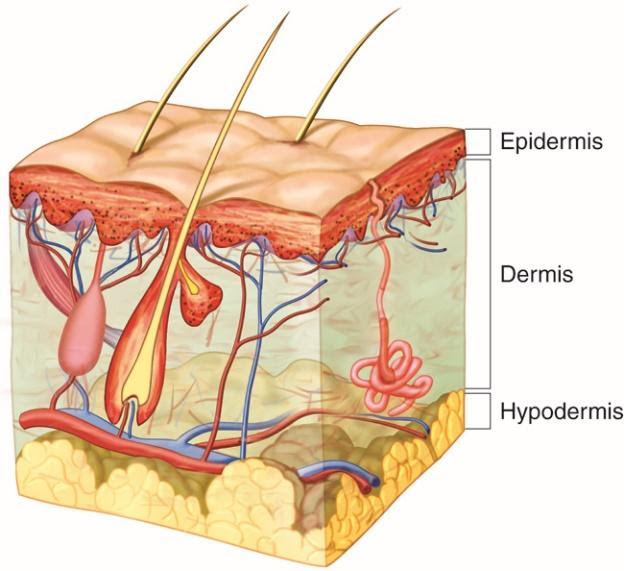
What layer of skin contains the blood vessels and nerves?
Answer
461.7k+ views
Hint: There are two layers to the skin. The epidermis, or epithelial layer, and the dermis, or connective tissue layer, are the two layers that make up the epidermis. These two layers sit on the Hypodermis, or subcutaneous tissue, which is a connective tissue layer. A dense network of blood and lymphatic vessels can be found in the connective tissue layer of the skin (dermis). Blood vessels do not exist in the epidermis.
Complete answer:
The dermis contains the majority of the nerve tissue that supplies the skin, including encapsulated and enlarged receptors. However, the epidermis also contains nerve tissue (the free nerve endings). The skin is the body's most extensive sensory receptor, and both of its layers contain nerve tissue.
Blood arteries and nerves go through the root, supplying blood and sensation to the entire tooth. The "pulp" of the tooth refers to this area. All of the teeth are connected to the jawbone. Keratinized, stratified squamous epithelium makes up the epidermis. Depending on where it occurs in the body, it is made up of four or five layers of epithelial cells. It does not contain any blood vessels.
The dermis, or middle layer of skin, contains blood vessels, nerves, and glands that help our skin operate. The subcutis, or inner layer of the skin, contains fat that protects us from harm. As a result, the dermis houses all of the skin's blood vessels as well as the majority of its nerve tissue.

Note:
The epidermis and dermis are the two layers of the skin. The hypodermis, or subcutaneous fatty tissue, lies beneath the dermis. Protection, regulation, and feeling are the three basic functions of the skin. The epidermis, or outermost layer of skin, determines our skin tone and serves as a waterproof barrier.
Complete answer:
The dermis contains the majority of the nerve tissue that supplies the skin, including encapsulated and enlarged receptors. However, the epidermis also contains nerve tissue (the free nerve endings). The skin is the body's most extensive sensory receptor, and both of its layers contain nerve tissue.
Blood arteries and nerves go through the root, supplying blood and sensation to the entire tooth. The "pulp" of the tooth refers to this area. All of the teeth are connected to the jawbone. Keratinized, stratified squamous epithelium makes up the epidermis. Depending on where it occurs in the body, it is made up of four or five layers of epithelial cells. It does not contain any blood vessels.
The dermis, or middle layer of skin, contains blood vessels, nerves, and glands that help our skin operate. The subcutis, or inner layer of the skin, contains fat that protects us from harm. As a result, the dermis houses all of the skin's blood vessels as well as the majority of its nerve tissue.

Note:
The epidermis and dermis are the two layers of the skin. The hypodermis, or subcutaneous fatty tissue, lies beneath the dermis. Protection, regulation, and feeling are the three basic functions of the skin. The epidermis, or outermost layer of skin, determines our skin tone and serves as a waterproof barrier.
Recently Updated Pages
Master Class 12 Business Studies: Engaging Questions & Answers for Success

Master Class 12 Economics: Engaging Questions & Answers for Success

Master Class 12 English: Engaging Questions & Answers for Success

Master Class 12 Maths: Engaging Questions & Answers for Success

Master Class 12 Social Science: Engaging Questions & Answers for Success

Master Class 12 Chemistry: Engaging Questions & Answers for Success

Trending doubts
What is meant by exothermic and endothermic reactions class 11 chemistry CBSE

Which animal has three hearts class 11 biology CBSE

10 examples of friction in our daily life

One Metric ton is equal to kg A 10000 B 1000 C 100 class 11 physics CBSE

1 Quintal is equal to a 110 kg b 10 kg c 100kg d 1000 class 11 physics CBSE

Difference Between Prokaryotic Cells and Eukaryotic Cells




